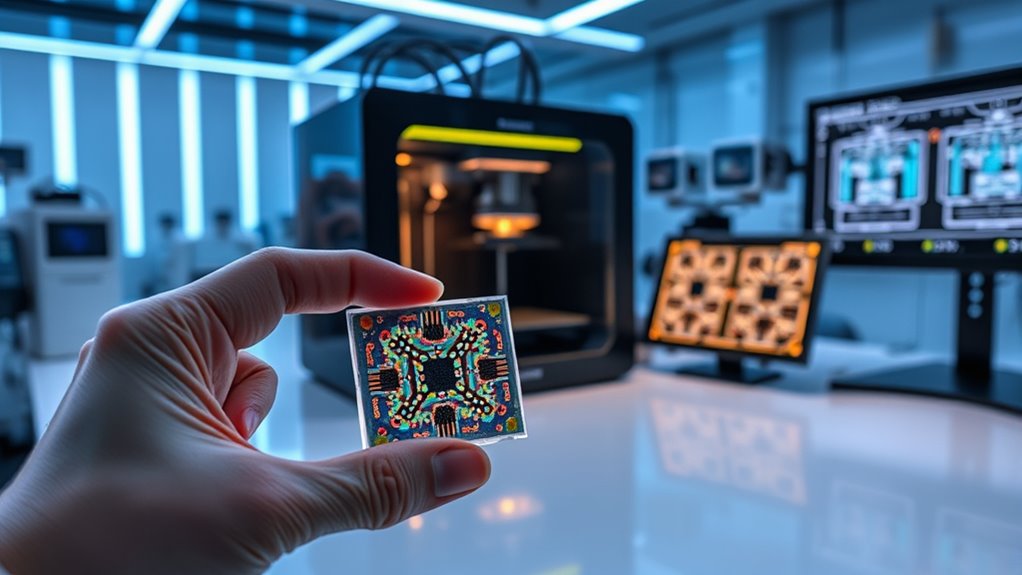Personalized vaccines printed on-demand are transforming medicine by offering rapid, tailored treatments based on your unique genetic and disease profiles. These vaccines can target individual tumor mutations or infectious agents, increasing effectiveness and reducing side effects. Using advanced technologies like AI, genomics, and portable printing systems, you can get a custom vaccine quickly when needed. Staying informed about these innovations means you’ll understand how personalized, on-demand vaccines could shape future healthcare approaches.
Key Takeaways
- On-demand personalized vaccines can be rapidly produced using advanced biomanufacturing technologies tailored to individual immune profiles.
- 3D printing and modular systems enable quick customization and deployment of vaccines specific to patient neoantigens.
- Artificial intelligence-driven design accelerates neoantigen identification for precise, patient-specific vaccine formulation.
- Modular printing platforms facilitate scalable, cost-effective production of personalized vaccines at the point of care.
- Integrating genomics and rapid manufacturing allows for swift, customized vaccine creation in response to emerging health needs.

Have you ever wondered how vaccines could become more effective by tailoring them to your unique genetic makeup? The idea of personalized vaccines is transforming the way we approach disease prevention and treatment. Unlike traditional vaccines that target broad populations against specific pathogens, personalized vaccines are custom therapies built using your individual genetic or biomarker data. This approach allows for precise targeting of your immune system, increasing the chances of a strong, effective response. It’s not just about prevention anymore; personalized vaccines are opening doors to treating and potentially curing diseases, especially cancer and complex infectious illnesses.
Personalized vaccines tailor immune responses using your unique genetic and biomarker data, transforming disease prevention and treatment.
When it comes to cancer, personalized vaccines focus on neoantigens—unique mutations found only in your tumor cells. By identifying these specific markers, scientists can develop vaccines that train your immune system to recognize and attack the cancer precisely where it’s most vulnerable. This method tackles the vast heterogeneity of tumors, which often vary substantially from person to person. Viral vector platforms are increasingly used to deliver these vaccines because they’re safer and produce a more robust immune response. Clinical trials have shown promising results, demonstrating that these vaccines are safe and can trigger anti-tumor activity across various cancer types.
To create these tailored vaccines, cutting-edge technologies come into play. Genomics, transcriptomics, proteomics, and immunology data are integrated to identify the most relevant targets for each individual. Rapid vaccine generation systems enable quick responses, especially for emerging infectious diseases, which is vital during outbreaks. Artificial intelligence and machine learning further accelerate this process by helping identify the best neoantigens for each patient. AI also helps customize mRNA or DNA vaccines by designing precise epitopes that match your immune profile, making the entire process faster and more accurate. Advances in viral vector technology improve production efficiency and immune targeting, ensuring the vaccines are both potent and safe. Additionally, understanding the distribution of store hours in different regions can help optimize vaccine rollout strategies by aligning delivery times with community access.
Your genetic makeup and immunological profile influence how you respond to vaccines. Variations in genes, gender, ethnicity, and other factors can affect antibody production and overall efficacy. Some individuals may carry alleles that reduce vaccine effectiveness or make them more sensitive to side effects. Personalized vaccines can be tailored to overcome these genetic and immunological barriers, leading to better outcomes. By understanding your unique genetic and immune profile, scientists can design vaccines that maximize effectiveness and minimize risks.
The benefits are clear: increased specificity leads to stronger immune responses, fewer adverse reactions, and the potential for dual prevention and treatment strategies. Personalized vaccines can adapt rapidly to mutating pathogens, supporting broader public health efforts. However, scaling up this technology presents challenges, including technical complexity, ethical considerations, and economic factors. Despite these hurdles, the promise of printed on-demand personalized vaccines offers a future where your immune system is empowered to fight diseases more effectively than ever before. Continued advancements in biomanufacturing are expected to make these vaccines more accessible and cost-effective, further accelerating their adoption worldwide.
Frequently Asked Questions
How Quickly Can Personalized Vaccines Be Developed After Diagnosis?
You’re wondering how fast personalized vaccines can be created after diagnosis. Currently, the process takes about 4 to 6 weeks, starting with tumor biopsy, genetic sequencing, and neoantigen identification. Then, manufacturing the vaccine, often using mRNA technology, adds another 2 to 4 weeks. Ongoing improvements aim to shorten this timeline, with future estimates suggesting vaccines could be ready in less than four weeks, speeding up treatment options considerably.
What Are the Main Technological Challenges in On-Demand Vaccine Printing?
You face several technological challenges in on-demand vaccine printing. Precise customization requires advanced 3D printing tech to tailor microneedle shapes and sizes, but this equipment is costly and complex. Ensuring consistent dose delivery and antigen stability is difficult, especially with dissolvable microneedles. Additionally, maintaining sterility, achieving scalable production, and validating long-term safety pose significant hurdles, making it tough to produce reliable, high-quality vaccines quickly and efficiently.
Are Personalized Vaccines Affordable for Widespread Use?
You might wonder if personalized vaccines are affordable for widespread use. Currently, they face significant cost barriers due to custom manufacturing, high fixed infrastructure expenses, and complex logistics. These factors keep prices high per dose, limiting access, especially in lower-income regions. Despite promising market growth, without advances in scalable production and reimbursement policies, making personalized vaccines broadly affordable remains a considerable challenge.
How Do Personalized Vaccines Differ From Traditional Vaccines in Efficacy?
Picture pinpoint precision, where personalized vaccines target tailored triggers for your immune system. Unlike traditional vaccines, which broadly boost immunity, personalized vaccines focus on specific genetic and immunological factors, enhancing effectiveness. You benefit from boosted responses and minimized side effects. This targeted approach means better protection, fewer setbacks, and a more customized cure, revolutionizing vaccination with a sharper, safer, and more successful strategy tailored just for you.
What Regulatory Hurdles Exist for On-Demand Personalized Vaccine Production?
You face regulatory hurdles like complex classification as ATMPs, which means standards are constantly evolving. You need to guarantee quality, safety, and efficacy, even with rapid, on-demand production. Manufacturing constraints, such as sterility and limited pre-release testing, challenge your timelines. Additionally, stability testing becomes difficult because vaccines are produced after patient enrollment. You must also adapt clinical trial designs to account for personalized, fast-paced production processes.
Conclusion
With personalized vaccines printed on-demand, you’re stepping into a future where disease becomes a shadow of the past. Imagine a world where every shot is tailored just for you, fighting off illnesses with unmatched precision. This breakthrough isn’t just a leap forward—it’s a revolution that could save countless lives and transform healthcare forever. Embrace this incredible innovation, because you’re on the brink of a medical breakthrough so powerful it could change everything you thought you knew about health.









